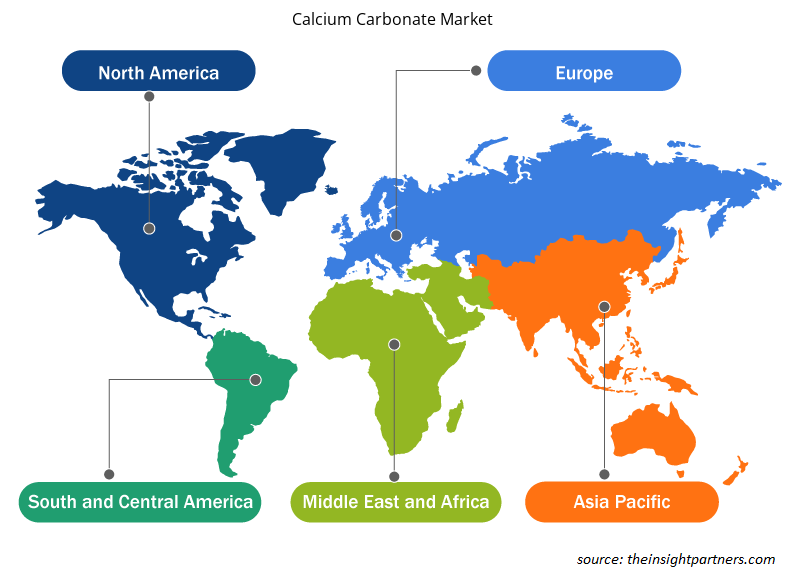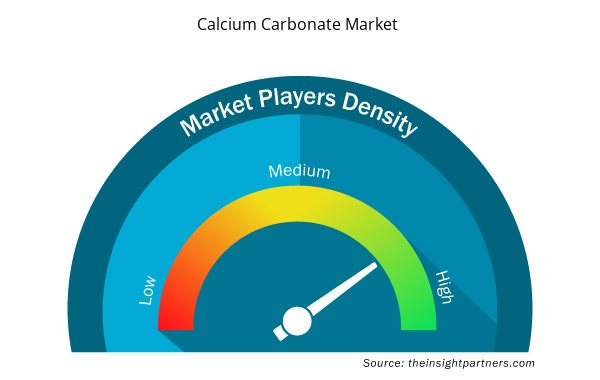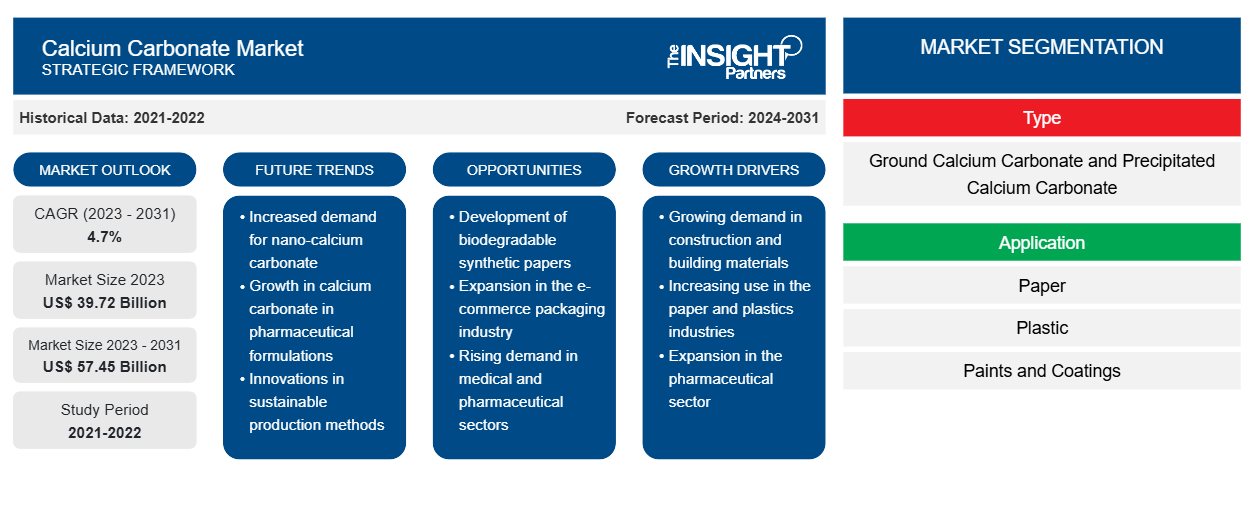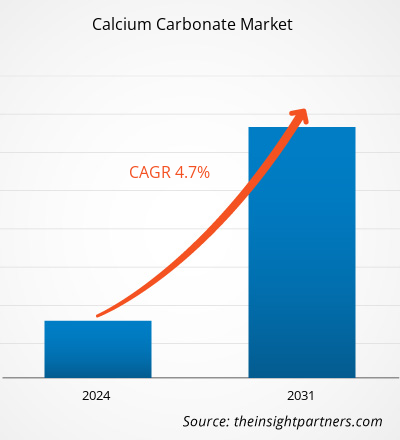Der Markt für Calciumcarbonat soll von 39,72 Milliarden US-Dollar im Jahr 2023 auf 57,45 Milliarden US-Dollar im Jahr 2031 anwachsen. Der Markt soll zwischen 2023 und 2031 eine durchschnittliche jährliche Wachstumsrate (CAGR) von 4,7 % verzeichnen. Die steigende Nachfrage nach Mikro- und Nanopartikeln von Calciumcarbonat dürfte ein wichtiger Trend auf dem Calciumcarbonat-Markt bleiben.
Calciumcarbonat Marktanalyse
Die hohe Nachfrage nach Calciumcarbonat als Kunststofffüllstoff treibt das Marktwachstum vor allem voran. Calciumcarbonat wird in der Kunststoffindustrie häufig als Kunststofffüllstoff verwendet , normalerweise in Form von weißem Granulat. Kunststofffüllstoff, der hauptsächlich aus Calciumcarbonat und Basisharz besteht, wird bevorzugt, da Calciumcarbonat reichlich vorhanden und leicht erhältlich ist. Außerdem verbessert es die physikalischen Eigenschaften von Kunststoff. Darüber hinaus ist Calciumcarbonat nicht umweltschädlich.
Calciumcarbonat Marktübersicht
Calciumcarbonat ist eine chemische Verbindung mit der Molekülformel CaCO3, die aus Calcium, Kohlenstoff und Sauerstoff besteht. Es kommt in der Natur häufig als Mineral vor und ist der Hauptbestandteil verschiedener Gesteine wie Kalkstein, Marmor und Kreide. Aufgrund seiner vielseitigen Eigenschaften wird Calciumcarbonat in verschiedenen Branchen und Anwendungen häufig verwendet. Es ist ein weißes, geruchloses Pulver, das in Wasser unlöslich, aber in Säuren löslich ist. Es dient als Nahrungsergänzungsmittel für Calcium und wird als Füllstoff oder Pigment bei der Herstellung von Papier, Kunststoffen, Farben und Beschichtungen verwendet. Darüber hinaus wird es hauptsächlich bei der Herstellung von Zement und Keramik eingesetzt.
Passen Sie diesen Bericht Ihren Anforderungen an
Sie erhalten kostenlos individuelle Anpassungen an jedem Bericht, einschließlich Teilen dieses Berichts oder einer Analyse auf Länderebene, eines Excel-Datenpakets sowie tolle Angebote und Rabatte für Start-ups und Universitäten.
- Holen Sie sich die wichtigsten Markttrends aus diesem Bericht.Dieses KOSTENLOSE Beispiel umfasst eine Datenanalyse von Markttrends bis hin zu Schätzungen und Prognosen.
Calciumcarbonat-Markttreiber und -Chancen
Hohe Nachfrage nach Calciumcarbonat aus der Papierindustrie
Die anhaltende Nachfrage aus der Papierindustrie spielt eine entscheidende Rolle für das Wachstum des Calciumcarbonat-Marktes. Calciumcarbonat wird in großem Umfang als Füllstoff und Beschichtungspigment bei der Herstellung von Papier- und Kartonprodukten verwendet. Es verbessert die Helligkeit, Opazität und Glätte des Papiers und verbessert so seine Bedruckbarkeit und Gesamtqualität. Da die Papierindustrie aufgrund von Faktoren wie Bevölkerungswachstum, Urbanisierung und der Nachfrage nach Verpackungsmaterialien weiterhin weltweit ein stetiges Wachstum verzeichnet, bleibt die Nachfrage nach Calciumcarbonat als Schlüsselrohstoff konstant hoch.
Starkes Wachstum in der Baubranche
Calciumcarbonat wird bei der Herstellung von Zement und Beton verwendet. Es findet auch Anwendung bei der Herstellung von Asphalt und im Straßenbau. Der Industriebausektor erlebt aufgrund mehrerer Faktoren ein schnelles Wachstum, wie etwa der zunehmenden Errichtung neuer Fabriken und Industrieanlagen, steigender Investitionen und staatlicher Initiativen. In den USA ist der Industriebau ein wesentlicher Teil der Wirtschaft des Landes. Dieser Sektor ist seit langem ein Motor des Wirtschaftswachstums in den USA. Die wachsenden Industriebauaktivitäten in verschiedenen Ländern auf der ganzen Welt treiben das Wachstum des Calciumcarbonat-Marktes voran.
Segmentierungsanalyse des Calciumcarbonat-Marktberichts
Schlüsselsegmente, die zur Ableitung der Calciumcarbonat-Marktanalyse beigetragen haben, sind Typ und Anwendung.
- Basierend auf dem Typ ist der Calciumcarbonatmarkt in gemahlenes Calciumcarbonat und gefälltes Calciumcarbonat segmentiert. Das Segment gemahlenes Calciumcarbonat hatte im Jahr 2023 einen bedeutenden Marktanteil.
- Nach Anwendung ist der Markt in Papier, Kunststoff, Farben und Beschichtungen, Klebstoffe und Dichtstoffe, Bauwesen und andere unterteilt. Das Papiersegment hielt im Jahr 2023 einen erheblichen Marktanteil.
Calciumcarbonat Marktanteilsanalyse nach Geografie
Der geografische Umfang des Calciumcarbonat-Marktberichts ist hauptsächlich in fünf Regionen unterteilt: Nordamerika, Asien-Pazifik, Europa, Naher Osten und Afrika sowie Süd- und Mittelamerika.
Die Region Nordamerika hält einen bedeutenden Anteil am Weltmarkt. In Nordamerika hat die steigende Nachfrage nach nachhaltigen und umweltfreundlichen Materialien den Markt für Calciumcarbonat angekurbelt, insbesondere in Anwendungen wie Papier, Kunststoffen und Beschichtungen. In Europa haben strenge Umweltschutzbestimmungen und eine starke Betonung der Nachhaltigkeit die Nachfrage nach Calciumcarbonat als bevorzugte Alternative zu anderen mineralischen Füllstoffen angekurbelt. Im asiatisch-pazifischen Raum haben die schnelle Industrialisierung, Urbanisierung und das Bevölkerungswachstum die Nachfrage nach Baumaterialien, Kunststoffen und Papierprodukten angeheizt und so zum Marktwachstum von Calciumcarbonat beigetragen.
Regionale Einblicke in den Calciumcarbonat-Markt
Die regionalen Trends und Faktoren, die den Calciumcarbonat-Markt im Prognosezeitraum beeinflussen, wurden von den Analysten von Insight Partners ausführlich erläutert. In diesem Abschnitt werden auch die Calciumcarbonat-Marktsegmente und die geografische Lage in Nordamerika, Europa, im asiatisch-pazifischen Raum, im Nahen Osten und Afrika sowie in Süd- und Mittelamerika erörtert.

- Erhalten Sie regionale Daten zum Calciumcarbonat-Markt
Umfang des Calciumcarbonat-Marktberichts
| Berichtsattribut | Details |
|---|---|
| Marktgröße im Jahr 2023 | 39,72 Milliarden US-Dollar |
| Marktgröße bis 2031 | 57,45 Milliarden US-Dollar |
| Globale CAGR (2023 - 2031) | 4,7 % |
| Historische Daten | 2021-2022 |
| Prognosezeitraum | 2024–2031 |
| Abgedeckte Segmente | Nach Typ
|
| Abgedeckte Regionen und Länder | Nordamerika
|
| Marktführer und wichtige Unternehmensprofile |
|
Dichte der Akteure auf dem Calciumcarbonat-Markt: Auswirkungen auf die Geschäftsdynamik verstehen
Der Markt für Calciumcarbonat wächst rasant, angetrieben durch die steigende Nachfrage der Endverbraucher aufgrund von Faktoren wie sich entwickelnden Verbraucherpräferenzen, technologischen Fortschritten und einem größeren Bewusstsein für die Vorteile des Produkts. Mit steigender Nachfrage erweitern Unternehmen ihr Angebot, entwickeln Innovationen, um die Bedürfnisse der Verbraucher zu erfüllen, und nutzen neue Trends, was das Marktwachstum weiter ankurbelt.
Die Marktteilnehmerdichte bezieht sich auf die Verteilung von Firmen oder Unternehmen, die in einem bestimmten Markt oder einer bestimmten Branche tätig sind. Sie gibt an, wie viele Wettbewerber (Marktteilnehmer) in einem bestimmten Marktraum im Verhältnis zu seiner Größe oder seinem gesamten Marktwert präsent sind.
Die wichtigsten auf dem Calciumcarbonat-Markt tätigen Unternehmen sind:
- Cerne Calcium Unternehmen
- GCCP Resources LTD
- JM Huber Corporation
- Imerys SA
- Lafargeholcim
- Minerals Technologies Inc.
Haftungsausschluss : Die oben aufgeführten Unternehmen sind nicht in einer bestimmten Reihenfolge aufgeführt.

- Überblick über die wichtigsten Akteure auf dem Calciumcarbonat-Markt
Neuigkeiten und aktuelle Entwicklungen zum Calciumcarbonat-Markt
Der Calciumcarbonat-Markt wird durch die Erhebung qualitativer und quantitativer Daten nach Primär- und Sekundärforschung bewertet, die wichtige Unternehmensveröffentlichungen, Verbandsdaten und Datenbanken umfasst. Im Folgenden finden Sie eine Liste der Entwicklungen auf dem Calciumcarbonat-Markt und der Strategien:
- Cimbar Resources, Inc. gab heute bekannt, dass es die Übernahme der Produktionsanlagen für Calciumcarbonate in Sahuarita, AZ, von Imerys Carbonates, USA Inc. abgeschlossen hat. (Quelle: CIMBAR RESOURCES, INC., Unternehmenswebsite/News/2022)
- Imerys gibt heute neue Investitionen zur Kapazitätserweiterung und -optimierung im Werk Sylacauga (AL) bekannt, dem größten Standort der Gruppe in Nordamerika. Diese Investition ist Teil eines dreijährigen Standortplans zur Unterstützung der wachsenden Nachfrage nach gemahlenen Calciumcarbonatprodukten und zugleich Teil des Engagements von Imerys, sein Geschäft in den Gemeinden und Regionen, in denen es tätig ist, auszubauen. (Quelle: Imerys, Unternehmenswebsite/Medienraum/Pressemitteilung/2022)
Calciumcarbonat-Marktbericht – Umfang und Ergebnisse
Der Bericht „Calciumcarbonat-Marktgröße und -prognose (2021–2031)“ bietet eine detaillierte Analyse des Marktes, die die folgenden Bereiche abdeckt:
- Marktgröße und Prognose auf globaler, regionaler und Länderebene für alle wichtigen Marktsegmente, die im Rahmen des Projekts abgedeckt sind
- Marktdynamik wie Treiber, Beschränkungen und wichtige Chancen
- Wichtige Zukunftstrends
- Detaillierte Porter's Five Forces und SWOT-Analyse
- Globale und regionale Marktanalyse mit wichtigen Markttrends, wichtigen Akteuren, Vorschriften und aktuellen Marktentwicklungen
- Branchenlandschaft und Wettbewerbsanalyse, einschließlich Marktkonzentration, Heatmap-Analyse, prominenten Akteuren und aktuellen Entwicklungen
- Detaillierte Firmenprofile
- Historische Analyse (2 Jahre), Basisjahr, Prognose (7 Jahre) mit CAGR
- PEST- und SWOT-Analyse
- Marktgröße Wert/Volumen – Global, Regional, Land
- Branche und Wettbewerbsumfeld
- Excel-Datensatz


- Drain Cleaning Equipment Market
- Molecular Diagnostics Market
- Precast Concrete Market
- Dry Eye Products Market
- Radiopharmaceuticals Market
- Oxy-fuel Combustion Technology Market
- Data Center Cooling Market
- Equipment Rental Software Market
- Portable Power Station Market
- Excimer & Femtosecond Ophthalmic Lasers Market

Report Coverage
Revenue forecast, Company Analysis, Industry landscape, Growth factors, and Trends

Segment Covered
This text is related
to segments covered.

Regional Scope
North America, Europe, Asia Pacific, Middle East & Africa, South & Central America

Country Scope
This text is related
to country scope.
Trends and growth analysis reports related to Chemicals and Materials : READ MORE..
The Insight Partners performs research in 4 major stages: Data Collection & Secondary Research, Primary Research, Data Analysis and Data Triangulation & Final Review.
- Data Collection and Secondary Research:
As a market research and consulting firm operating from a decade, we have published and advised several client across the globe. First step for any study will start with an assessment of currently available data and insights from existing reports. Further, historical and current market information is collected from Investor Presentations, Annual Reports, SEC Filings, etc., and other information related to company’s performance and market positioning are gathered from Paid Databases (Factiva, Hoovers, and Reuters) and various other publications available in public domain.
Several associations trade associates, technical forums, institutes, societies and organization are accessed to gain technical as well as market related insights through their publications such as research papers, blogs and press releases related to the studies are referred to get cues about the market. Further, white papers, journals, magazines, and other news articles published in last 3 years are scrutinized and analyzed to understand the current market trends.
- Primary Research:
The primarily interview analysis comprise of data obtained from industry participants interview and answers to survey questions gathered by in-house primary team.
For primary research, interviews are conducted with industry experts/CEOs/Marketing Managers/VPs/Subject Matter Experts from both demand and supply side to get a 360-degree view of the market. The primary team conducts several interviews based on the complexity of the markets to understand the various market trends and dynamics which makes research more credible and precise.
A typical research interview fulfils the following functions:
- Provides first-hand information on the market size, market trends, growth trends, competitive landscape, and outlook
- Validates and strengthens in-house secondary research findings
- Develops the analysis team’s expertise and market understanding
Primary research involves email interactions and telephone interviews for each market, category, segment, and sub-segment across geographies. The participants who typically take part in such a process include, but are not limited to:
- Industry participants: VPs, business development managers, market intelligence managers and national sales managers
- Outside experts: Valuation experts, research analysts and key opinion leaders specializing in the electronics and semiconductor industry.
Below is the breakup of our primary respondents by company, designation, and region:

Once we receive the confirmation from primary research sources or primary respondents, we finalize the base year market estimation and forecast the data as per the macroeconomic and microeconomic factors assessed during data collection.
- Data Analysis:
Once data is validated through both secondary as well as primary respondents, we finalize the market estimations by hypothesis formulation and factor analysis at regional and country level.
- Macro-Economic Factor Analysis:
We analyse macroeconomic indicators such the gross domestic product (GDP), increase in the demand for goods and services across industries, technological advancement, regional economic growth, governmental policies, the influence of COVID-19, PEST analysis, and other aspects. This analysis aids in setting benchmarks for various nations/regions and approximating market splits. Additionally, the general trend of the aforementioned components aid in determining the market's development possibilities.
- Country Level Data:
Various factors that are especially aligned to the country are taken into account to determine the market size for a certain area and country, including the presence of vendors, such as headquarters and offices, the country's GDP, demand patterns, and industry growth. To comprehend the market dynamics for the nation, a number of growth variables, inhibitors, application areas, and current market trends are researched. The aforementioned elements aid in determining the country's overall market's growth potential.
- Company Profile:
The “Table of Contents” is formulated by listing and analyzing more than 25 - 30 companies operating in the market ecosystem across geographies. However, we profile only 10 companies as a standard practice in our syndicate reports. These 10 companies comprise leading, emerging, and regional players. Nonetheless, our analysis is not restricted to the 10 listed companies, we also analyze other companies present in the market to develop a holistic view and understand the prevailing trends. The “Company Profiles” section in the report covers key facts, business description, products & services, financial information, SWOT analysis, and key developments. The financial information presented is extracted from the annual reports and official documents of the publicly listed companies. Upon collecting the information for the sections of respective companies, we verify them via various primary sources and then compile the data in respective company profiles. The company level information helps us in deriving the base number as well as in forecasting the market size.
- Developing Base Number:
Aggregation of sales statistics (2020-2022) and macro-economic factor, and other secondary and primary research insights are utilized to arrive at base number and related market shares for 2022. The data gaps are identified in this step and relevant market data is analyzed, collected from paid primary interviews or databases. On finalizing the base year market size, forecasts are developed on the basis of macro-economic, industry and market growth factors and company level analysis.
- Data Triangulation and Final Review:
The market findings and base year market size calculations are validated from supply as well as demand side. Demand side validations are based on macro-economic factor analysis and benchmarks for respective regions and countries. In case of supply side validations, revenues of major companies are estimated (in case not available) based on industry benchmark, approximate number of employees, product portfolio, and primary interviews revenues are gathered. Further revenue from target product/service segment is assessed to avoid overshooting of market statistics. In case of heavy deviations between supply and demand side values, all thes steps are repeated to achieve synchronization.
We follow an iterative model, wherein we share our research findings with Subject Matter Experts (SME’s) and Key Opinion Leaders (KOLs) until consensus view of the market is not formulated – this model negates any drastic deviation in the opinions of experts. Only validated and universally acceptable research findings are quoted in our reports.
We have important check points that we use to validate our research findings – which we call – data triangulation, where we validate the information, we generate from secondary sources with primary interviews and then we re-validate with our internal data bases and Subject matter experts. This comprehensive model enables us to deliver high quality, reliable data in shortest possible time.


 Holen Sie sich ein kostenloses Muster für diesen Bericht
Holen Sie sich ein kostenloses Muster für diesen Bericht